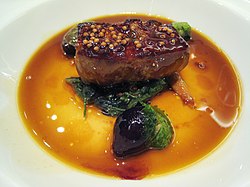Foie gras

Foie gras with mustard seeds and green onions in duck jus
|
|
| Type | whole, mousse, parfait, or spread |
|---|---|
| Main ingredients | Liver of a duck or goose |
| |
|
| Nutritional value per 100 g (3.5 oz) | |
|---|---|
| Energy | 1,933 kJ (462 kcal) |
|
4.67 g
|
|
| Dietary fiber | 0.0 g |
|
43.84 g
|
|
|
11.40 g
|
|
| Vitamins | |
| Thiamine (B1) |
(8%)
0.088 mg |
| Riboflavin (B2) |
(25%)
0.299 mg |
| Niacin (B3) |
(17%)
2.51 mg |
| Minerals | |
| Sodium |
(46%)
697 mg |
|
|
| Percentages are roughly approximated using US recommendations for adults. | |
Foie gras (![]() i/ˌfwɑːˈɡrɑː/, French for "fat liver") is a luxury food product made of the liver of a duck or goose that has been specially fattened. By French law, foie gras is defined as the liver of a duck or goose fattened by force-feeding corn with a feeding tube, a process also known as gavage. In Spain and other countries outside France it is occasionally produced using natural feeding. Ducks are force-fed twice a day for 12.5 days and geese three times a day for around 17 days. Ducks are typically slaughtered at 100 days and geese at 112 days.
i/ˌfwɑːˈɡrɑː/, French for "fat liver") is a luxury food product made of the liver of a duck or goose that has been specially fattened. By French law, foie gras is defined as the liver of a duck or goose fattened by force-feeding corn with a feeding tube, a process also known as gavage. In Spain and other countries outside France it is occasionally produced using natural feeding. Ducks are force-fed twice a day for 12.5 days and geese three times a day for around 17 days. Ducks are typically slaughtered at 100 days and geese at 112 days.
Foie gras is a popular and well-known delicacy in French cuisine. Its flavor is described as rich, buttery, and delicate, unlike that of an ordinary duck or goose liver. Foie gras is sold whole, or is prepared into mousse, parfait, or pâté, and may also be served as an accompaniment to another food item, such as steak. French law states that "Foie gras belongs to the protected cultural and gastronomical heritage of France."
...
Wikipedia
